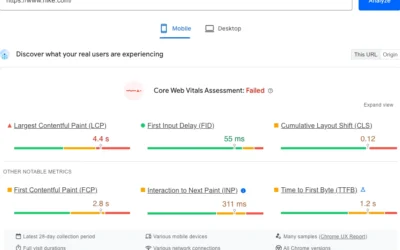How To Use AI Content For SEO Success

AI is the future of SEO but does that mean AI content can be successful now? Shane Hampson analyzed hundreds of LinkedIn’s top rankings both before and after the October 2023 broad core update to help provide insights into this creative use of AI-generated content.
Can you have a successful content strategy using AI-generated content?
Google has softened it’s stance on AI content over the last few years at first calling AI-generated content low quality in a YouTube video. However, since then Google has updated it’s stance by saying any content is acceptable as long as it’s “helpful” and not used to game the algorithm which is spam. The question then becomes, what does that mean and how do you use AI-generated content to make your content helpful and high quality?

LinkedIn is using AI and Real Contributors
LinkedIn which is the number one social media network for business professionals is using an interesting take with the creation of AI-generated content but adds to the AI content by allowing their users to “contribute” to each of these AI-generated articles. In theory, this makes sense – allow experts in their field to add their expert opinions on these articles to contribute to the “helpfulness” of their content.
LinkedIn created new “expert” badge for creators who are topic experts
The results of LinkedIn collaborative articles are impressive from an engagement point of view with some topics having over 3,300 contributions from real people, considered experts in their field. Although anyone can participate in these collaborative articles, LinkedIn will give people they deem as experts with various types of badges to signify their expertise on certain topics.

Does Google find AI content helpful when using unique content from humans? (Results)
In the first 6 months LinkedIn seemed to experience amazing growth with this ultra-creative and aggressive content strategy picking up 811,000+ keywords and nearly 200,000 keywords on the first page (including SERP features) which is an incredible feat in itself. The keywords were impactful driving in nearly 800,000 traffic clicks.

However, Google announced a helpful content update in September and another 2023 October broad core update which seemed to have a negative impact on this content strategy resulting in a 43% decline in keywords and traffic.

However, it’s too early to say that it was the updates alone that drove this decline in performance. LinkedIn likely missed on some other areas of technical SEO that didn’t give this content strategy the absolute best shot at long-term sustained success.
How to recover from Helpful Content Penalty: Case Study
How can LinkedIn improve its SEO strategy?
One surprising thing they are missing out on is their lack of logical hierarchy with their subfolder structure. I believe they could take advantage of all of these collaborative articles by migrating their multiple subfolders into one that could make it incredibly powerful and drive more authority.
Each of these collaborative articles lives under the /advice/ subfolder which is followed by a # in this example it’s linkedin.com/advice/0

However, their database of collaborative articles lives under the subfolder /pulse/topics/home. LinkedIn could get rid of the/home portion because it does not add any inherent value and adds an additional subfolder with nothing underneath it to support it.

(And unfortunately, it does not 301 (re-direct) when you remove the /home/ section)

When you search by topic category those are also under different subfolders, this subfolder is called “/pulse/topics/browse”. This makes sense and is a logical subfolder under the pulse/topics category, the issue here is once you find a topic the /pulse/topics/ subfolder isn’t building authority like it could be.

Once you click a topic, it’s a different subfolder which is expected but I believe even this subfolder could become more authoritative (debatable) but it could more user-friendly at minimum by removing the unnecessary characters at the end of each “topic” in this instance LinkedIn could remove the -s48473/ from the subfolder

By doing this, LinkedIn is losing the natural advantage of having all of their content under one powerful subfolder that would build great topical authority. Instead, when you do a “site: command” you do not see any of the many articles under this topic category.

These SERPs should be filled with all of the various collaborative articles created about the SEO Audits topic, as you can see above it is not.
Final Thoughts and Verdict
I truly love what LinkedIn is doing with this creative SEO and content strategy attempting to blend AI-generated content with contributions from industry experts and believe this is a sustainable model moving forward if they make just a few technical SEO changes to give all of this content the best chance at performing well in the search engines. I also wouldn’t be surprised if LinkedIn adds an additional button on individual’s profiles that highlight their collaborative article contributions rather than housing them under the comments sections. Amazing job here LinkedIn and I hope more companies continue to think creatively and push the SEO envelope.
Shane Hampson
Ethical SEO Consultant
Data Driven Marketer. Fantasy Football Champion. Dog Lover. Foodie.
Ready to take your SEO to the next level?
Now that you’re on a mission to make your website friendly to the search engines, it’s time to plan your next move. Feel free to book a strategy session, and we can discuss your plan of action.
Recent Blog Posts
Can you use interstitials for SEO?
What are interstitials and are they good for SEO? Should you avoid intrusive interstitials? What does Google say?
Using PreLoad, PreConnect and Prefetch for SEO
Learn how to use pre-load, pre-connect and pre-fetch to boost your SEO site speed and Core Web Vitals.
How To Optimize For Core Web Vitals
Core Web Vitals are a set of specific factors that measure loading performance, interactivity, and visual stability of a web page, and they are crucial for providing a good user experience and improving SEO.



